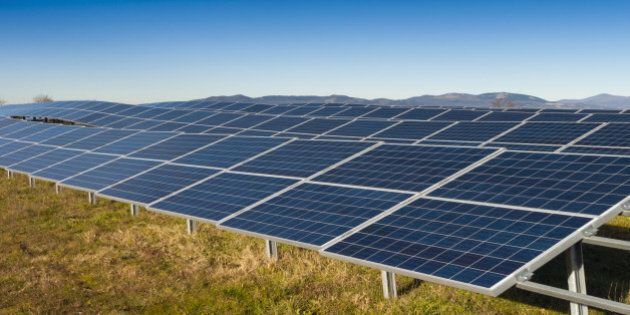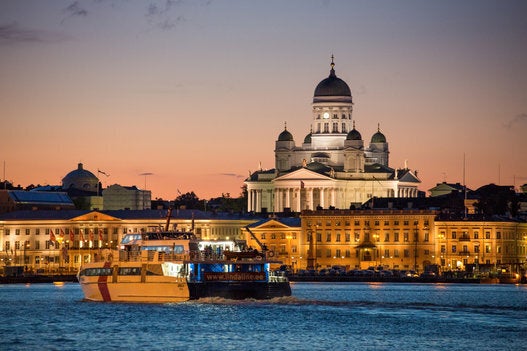
By Guy Dauncey
Goal 7: Ensure access to affordable, reliable, sustainable, and modern energy for all
The United Nations Sustainable Development Goals have such a grand, evocative ring, and they include a goal on energy, a huge concern for everyone's future. So what does the goal ask for -- and can we meet it?
Affordable: Solar energy was not affordable when NASA first used it in space, but its price has fallen 100-fold since the 1970s, and in many parts of the world it is now a financially viable long-term option. Wind energy is now the cheapest kind of new power. The more we increase the efficiency of our buildings, vehicles and appliances, the less they will cost to run.
Reliable: Just put a qualified engineer on the job, and you'll get reliability.
Sustainable: Firewood is not sustainable, except on a very small, managed scale. Fossil fuels are not sustainable for a host of reasons. Nuclear power is not sustainable. Only three sources are sustainable: renewable energy from the sun (solar, wind, wave, hydro and sustainably managed biofuels); tidal energy from the moon and sun; and geothermal energy from the earth, all combined with efficiency, power storage and load management.
Modern: Back in 1900 the motorcar was modern. So was Picasso's art, once upon a time.
For All: This is the real challenge, to achieve the transition to 100 per cent renewable energy for everyone on Earth -- by 2030. This includes countries like Russia and Saudi Arabia, whose economies depend on fossil fuel exports, and like China and India, which are still hooked on coal. The challenge is enormous, but so is the climate crisis, which is breathing down our necks with increasing fires, floods, storms and sea-level rise.
Is it really possible? Here's where technology, finance and politics enter the stage.
For electricity, the transition needs political will, and the right policies to send a positive signal to investors. Alberta has just announced that it will phase out all coal-fired power by 2030. Saskatchewan has announced that it will produce half its power from renewables by 2030. The European Union is on target to produce 20 per cent of its electricity from renewables by 2020. China is engaged in a massive solar acceleration.
Could the whole world achieve it by 2030? It's technically possible, but only if the climate alarm bells ring far more loudly and widely, including in the U.S. Congress, generating a far more urgent will to act.
For transportation, the challenge is more difficult. By the early 2020s, with the falling price of batteries, electric cars will be priced the same as regular cars, and cost far less to run. BMW has said that by 2025 it will cease making regular cars. Electric buses are already in operation, and cities can do much to make roads more pedestrian and bicycle-friendly. But for long-distant transportation by road, air and sea there are no solutions in sight yet. There may be a breakthrough in batteries or hydrogen, but there's a long way to go.
For heat, the challenge is even tougher. With the right policies, all new buildings can be built to the Passive House standard, being so well constructed that they need 90 per cent less heat, which can be obtained through a heat recovery ventilation unit. In Brussels and various German cities every new building must already meet the Passive House standard. But what about the millions of existing buildings, from factories to high-rises? The retrofit task is huge, to make every building more efficient and to replace oil and gas with heat-pumps, renewably sourced district heat or stored summer solar heat, as they do at Drake Landing in Okotoks, Alberta. And what about industrial heat to make iron, steel and cement? There are proposals and prototypes, but nothing ready to roll out.
The Age of Firewood lasted more than 300,000 years. The Age of Fossil Fuels will last for 300 years. Without fossil fuels, for all their dirt and danger, we could never have developed the science and engineering that underlie so much that we cherish. The Solar Age will last for well over a billion years, and with every passing month, its technologies will improve and prices will fall.
What does this mean for Canada? Until there is a clear goal, politicians will drift. Canada needs to set a clear goal, as Vancouver has done, to get to 100 per cent renewable energy as quickly as possible. To keep the temperature from rising by more than 2°C the climate science tells us that it needs to be done by 2030 -- but at least lets put the goal on the table.
This global energy transition is so huge and so historically significant that we can easily lose sight of it amid local battles over pipelines and coalmines. But it's happening. Our challenge is to make it happen fast enough.
Guy Dauncey is an author and futurist who works to develop a positive vision of a sustainable future, and to translate that vision into action. He lives on Vancouver Island, in Canada.
The views expressed in this blog are those of the authors, and do not necessarily reflect the positions of CCIC or its members.
ALSO ON HUFFPOST:
